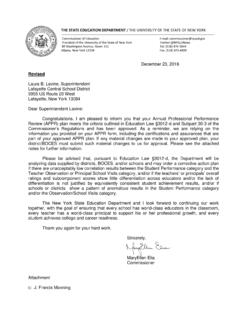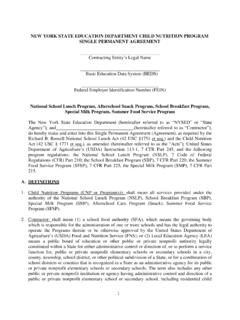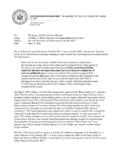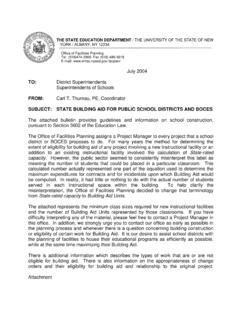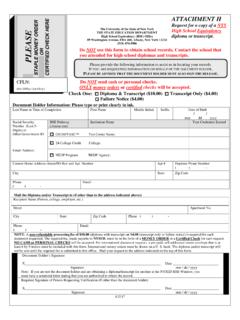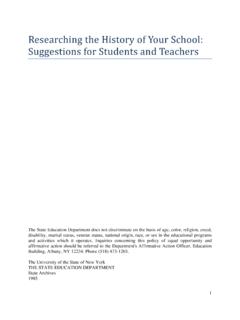Transcription of NEW YORK STATE EDUCATION DEPARTMENT - …
1 Buffalo CSD D Youville Porter June 2012 1 NEW york STATE EDUCATION DEPARTMENT Office of Accountability Differentiated Accountability School Quality Review Report (SQR) SCHOOL QUALITY REVIEW REPORT BEDS Code: 14 06 00 01 0003 District Name: Buffalo City School District School Name: PS 3 D Youville Porter Campus School School Address: 225 Porter Ave., Buffalo, NY 14213 Principal: Elizabeth Giangreco Accountability Phase/Category: Improvement (year 1) Comprehensive Area of Identification: English Language Arts All Students; Hispanic Students; Students with Disabilities; English Language Learners and Economically Disadvantaged Students Dates of On site Review: January 4, 2012 January 5, 2012 PART 1: MISSION STATEMENT To produce well rounded individuals with the EDUCATION and skills necessary to become productive citizens.
2 To accomplish this, the staff will ensure a safe and stable environment where students will be taught by dedicated and certified nurturing staff. The staff of School #3 will also encourage students to think logically and creatively and to express themselves articulately in all forms of communications relevant to a modern technological society. PART 2: SCHOOL STRENGTHS There is substantial parental support at the school this year. The Parent Teacher Organization (PTO) increased from three parent members to eighty five parent members from 2011 2012, and most of the teachers at the school are also members.
3 The school has had four different Principals in the last three years. The current Principal is energetic and has gained the trust of the staff and parents. The culture of the school has begun to change over the last year with a number of teachers taking on leadership roles. The school initiated an hour and a half District sponsored after school supplemental EDUCATION program in which over one hundred students participate. Buffalo CSD D Youville Porter June 2012 2 PART 3: FINDINGS AND RECOMMENDATIONS I. COLLECTION, ANALYSIS, AND UTILIZATION OF DATA FINDINGS: The data that the school collects is not being analyzed in a rigorous manner to identify precisely what aspects of English language arts (ELA) need to be the specific focus for improvement.
4 The analysis of data is not focused sharply enough to identify the key changes required in programs and delivery to bring about improvement in student performance. The school has not created or implemented a strategic plan to identify or address the causes of underperformance in ELA. There was no evidence that teachers used the collected assessment data to inform instruction. The staff appears to be looking at the data to rank student performance rather than to frame a cohesive and coherent plan for instruction. RECOMMENDATIONS: The Principal should request professional development (PD) support from the District in developing the essential teacher skills needed to implement a more rigorous and systematic analysis of data.
5 The school staff should hone these skills to identify precisely the aspects of ELA that are causing greatest concern. Plans should then be put in place to address these issues on either a school, grade or class level and to ensure that these areas are a focus for teaching and learning. The school leadership should monitor the analysis down to classroom practice and hold staff accountable to ensure that improvements are made. The school should conduct a thorough item analysis and subgroup analysis to determine the causes of underperformance and use this as the basis for developing the Comprehensive Educational Plan (CEP).
6 The data should be reviewed from year to year across cohorts with instructional needs adjusted accordingly. The school, with the support of the District, should provide PD for teachers in how to use data to improve instruction. This training should include the variety of methods that can be employed within the classroom to meet the individual learning needs of students. School leaders should identify this as a focus for observation. II. TEACHING AND LEARNING FINDINGS: The instruction for ELA students is primarily teacher directed with little variety of instructional strategies.
7 Students have few opportunities to engage in conversations working in pairs or talking with different groups of students. Buffalo CSD D Youville Porter June 2012 3 The review team observed few examples of differentiated instruction in ELA classrooms. There was little evidence that data was used to group students or to match tasks to the differing ability levels of the students. The co teaching model is neither effective nor skillfully implemented. There is insufficient time for the co teachers to plan together since many of them move from class to class during most of the school day.
8 Teachers and leaders report that for the majority of the ELA instructional time, one teacher is primarily responsible for the delivery of instruction and the other teacher plays the much less significant role of a teacher s assistant. Students are not fully benefiting from having two certified teachers in the ELA classroom. The teachers are not effectively distributing their time or attention to provide additional support to students or to work with small skill based groups. There is a lack of rigor in questioning strategies; higher order thinking and problem solving is absent from the ELA classes.
9 Students are asked to recall facts and details. Students are not challenged to analyze, evaluate or synthesize information. Although the school has begun to use Positive Behavioral Intervention and Supports (PBIS), not all students demonstrate a full understanding of the school's behavioral expectations. Some older students seem unaware of appropriate classroom routines, and others are resistant to following the rules and completing the assigned tasks. Students interviewed said they would do better if they could see their grades and get feedback on how they could improve.
10 They stated that in the classes where they were given specific feedback, it was an incentive to keep trying to improve. Parents echoed this by stating that when the students are having academic difficulty, they sometimes don t get the academic attention that they need to help them understand the material. RECOMMENDATIONS: School leaders should provide PD to introduce ELA teachers to a wider range of instructional strategies that can be used in the classroom to promote greater student participation in the learning process. Teachers should be expected to implement these strategies, and school leaders should monitor the effectiveness and provide additional PD for teachers when necessary.


